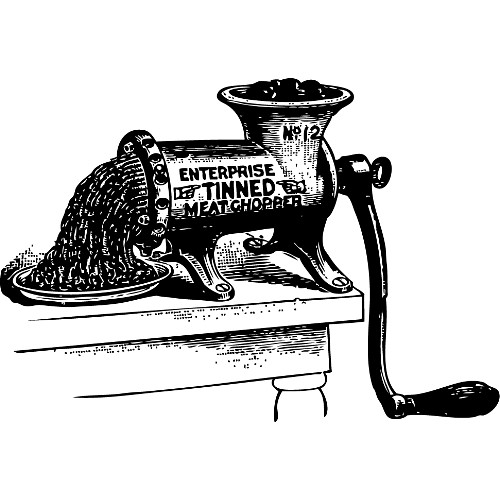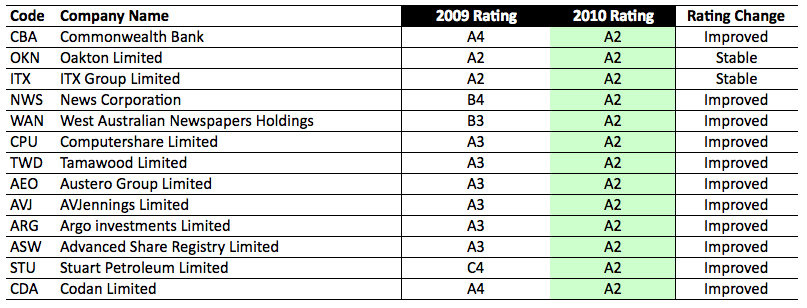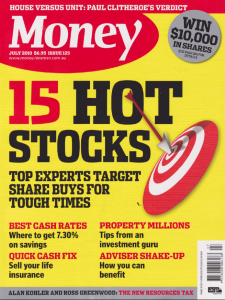Insightful Insights
-
Who is in front of the reporting season avalanche?
Roger Montgomery
August 17, 2010
 We are now two weeks into one of the most important times of the year for investors – reporting season. Eighty companies have reported to date, some good, some not so good – I know this because I track every single one. Yes, I am very busy. Are you wondering which companies are my A1’s now and which stocks I am interested in? In the last two weeks you will have heard me on TV saying I have bought a few things. Well, I don’t buy C5s so read on.
We are now two weeks into one of the most important times of the year for investors – reporting season. Eighty companies have reported to date, some good, some not so good – I know this because I track every single one. Yes, I am very busy. Are you wondering which companies are my A1’s now and which stocks I am interested in? In the last two weeks you will have heard me on TV saying I have bought a few things. Well, I don’t buy C5s so read on.TLS was a clear disappointment, as it has been since it listed. I have been on the front foot for a long time saying that this is a company to avoid, I hope you took notice. My valuation has fallen now from $3.00 to almost $2.50. If anyone can turn it around however I think Thodey can.
Qantas should have come as no surprise. A $300 million cash loss and I wouldn’t be surprised to see another raising of capital or debt.
Personally though I am not interested at all in TLS or QAN as investment candidates. I am only interested in the highest quality best performing businesses available – it’s here that intrinsic value can be created rather than destroyed and with reporting season just about to kick into top gear from this week, to find them, I put each company through the same rigorous process.
My initial screening process is a vital part of the investment process as it allows me to determine those companies that deserve to retain their place in the short list and it also highlights new opportunities as they arise. But to do this for some 2,000 listed Australian companies can be a very burdensome task unless you have a systematic way of analysing and comparing results in a consistent manner.
For me, it involves pulling out some 50-70 profit and loss, balance sheet and cash flow data fields from each annual report to populate my five models. All of these models employ industry specific metrics to calculate my quality and performance scores. This allows me to rank all companies from A1 – C5 to sort the wheat from the chaff.
For those not familiar with my ranking system, A1s are the simply the best businesses and the safest to own, while C5s are the poorest performers and the least safe.
Out of the 80 companies that have reported, only 5 have achieved my coveted A1 status – around 6.25% (the best of the rest).
NVT, JBH and COH had my A1 rating last year and retained it this year and there are 2 new entrants in MCE and RHD, with GCL (it was an A1 last year) having a dramatic rating decline. I tend to shy away from resource companies for obvious reasons.
On my blog I have previously spoken about NVT, JBH and COH and also mentioned ITX, so please revisit those thoughts. itX is under takeover and Navitas, it was recently reported, had been approached some time ago by Kaplan – a company I have done some consulting work for and a subsidiary of Warren Buffett’s Washington Post company – so a big tick for the A1 to C5 Rating system!
That only leaves MCE, an engineering business that currently generates most of its returns from the manufacture of riser buoyancy modules for deep-sea oil rigs. Its order book is already underwriting a doubling of revenue for 2011. The 2010 result revealed profits had almost tripled and significantly exceeded prospectus forecasts and it is producing returns on equity of 49% – a rate that is unavailable generally elsewhere. Borrowings amount to about $8 million compared to equity of about $60 million (of which a little over 10% is capitalised development and goodwill intangibles). Best of all, the share price over the last week is a long way below my estimate of its intrinsic value.
If you have seen me on TV or heard me on radio in the last week or so you would have heard me mention that I had bought something, MCE is it. Please be mindful that if you act rashly and go and push the share price up, you will be helping me perhaps more than yourself. Also remember that I am not recommending the stock to you and that I cannot forecast the share price direction (although I am pleased with its performance since my purchase). The share price, I warn you, could halve, for example if there is a recession and or the oil price plunges – delaying expenditure of the construction of oil rigs globally. I simply am not recommending it to you.
Also remember that I am under no obligation to keep you informed of when I buy or sell nor answer any specific questions, which means 1) you have to do your own research and 2) you have to be responsible for your own decisions. Seek and take personal professional advice BEFORE you do anything.
Moving on, another 13 companies have achieved my second highest rating of A2. They are listed below with their prior years rating so you can compare.
Noteworthy in this list is the excellent performance of the Commonwealth Bank (which I continue to hold in my Eureka Report Value Line portfolio, along with JBH and COH) and those companies I generally classify as being in the Information Technology sector including OKN, ITX, CPU and ASW. Both sectors appear to be doing well in aggregate.
While focus should always be placed on the A1’s (the top 5-7% of the market) at any one point in time, A2’s are still very high quality businesses. The use of the two lists in tandem will therefore provide you with an excellent starting point in isolating those who have reported high quality financials and performance levels above the average business. An important first step in the Value.able Montgomery brand of investing.
It is from here that I will select candidates worthy of further analysis (qualitative and quantitative) and possibly meet with company management, if I have not already done so. Once again I have taken you to the river I fish in, you have my fishing rods and tackle box. Now up to you to catch the right priced fish.
Please use these two lists as a starting point to conduct your own research and use Value.able as a guide to estimate your own valuations. If you don’t yet have a copy you can order one at www.rogermontgomery.com so you too can do your own valuations. Remember to always focus on the highest quality and best performing business available.
If you focus on the best when they are cheap and simply forget the rest, you should avoid more (if not all) of the disasters and should be able to build a portfolio that will give you a greater chance of out-performing the market.
Happy reporting season!
To be continued… Read Part II.
Post by Roger Montgomery, 17 August 2010.
by Roger Montgomery Posted in Companies, Insightful Insights, Investing Education.
-
The Results Revealed: How do your Value.able valuations compare?
Roger Montgomery
August 17, 2010
It has been a good ten days since I asked you the question ‘How do your Value.able valuations compare?’ And so the time has come to hand in your exam papers and reveal the results.
Some of you have pointed out that there were both 2009 and 2010 numbers in there. Yes, that is absolutely correct (but you don’t receive extra marks for pointing that out). If a company had announced 2010 results, I used the latest numbers. For this exercise I only wanted you to use the numbers to calculate the Value.able value, based on them.
The next exam is going to be a ‘finding-the-data’ test. I will nominate a company and select an annual report and you will all have to go and download it and dig up the numbers. Expect there to be some red herrings in there too. It is your money you are dealing with so it is reasonable to make sure you are being conservative.
Here are my answers to the samples I listed last week. I hope you had a chance to practice. There will be another set of examples soon so you can have another go.
The recent CFA exam saw only 39% of participants pass, so don’t be too hard on yourself if you are out on your first attempt. As Sir Francis Bacon, the 1st Viscount of St. Alban said: Truth will sooner come out of error than from confusion.
Posted by Roger Montgomery, 17 August 2010.
by Roger Montgomery Posted in Insightful Insights.
- 74 Comments
- save this article
- POSTED IN Insightful Insights
-
What do you think of the QAN, JBH and ITX results Roger?
Roger Montgomery
August 12, 2010
 Here we are in the midst of reporting season and there are some reasonably predictable results. Qantas reported a profit today that was less than a quarter of its profit more than ten years ago. The airline reported a $112 million profit but that was boosted by $1 billion of revenue from its Frequent Flyer program and a $300 reduction in employment costs. For those of you interested in the real numbers, the company actually lost $302 million (see my chapter in Value.able on cash flow) and this can be explained by the very wide gap between the depreciation item in the profit and loss statement and the real expenditure on property plant & equipment. Depreciation looks backwards, but new planes cost more.
Here we are in the midst of reporting season and there are some reasonably predictable results. Qantas reported a profit today that was less than a quarter of its profit more than ten years ago. The airline reported a $112 million profit but that was boosted by $1 billion of revenue from its Frequent Flyer program and a $300 reduction in employment costs. For those of you interested in the real numbers, the company actually lost $302 million (see my chapter in Value.able on cash flow) and this can be explained by the very wide gap between the depreciation item in the profit and loss statement and the real expenditure on property plant & equipment. Depreciation looks backwards, but new planes cost more.Separately, JB Hi-Fi’s result was excellent but my concern is that its $94 million of cash flow (of which $67 million was allocated to dividends and $20 million allocated to paying down debt) is superfluous to its needs. Take a look at the biggest asset on the balance sheet – Inventory of $334 million. Then take a look at the creditors item in the current liabilities section. Almost the same amount!
Think about it this way; the suppliers are funding the inventory so the company doesn’t even need cash to pay have the stuff it sells and that are on its shelves. Actually it really does, the gap is about what is left over once we subtract the debt repayment and dividends from the cash flow. It is small though. Once the debt is gone and the cash keeps growing it may do something that could harm intrinsic value.
Now don’t get me wrong; JB Hi-Fi is an amazing business that retained its A1 status in this result and the risk associated with its plans to roll out more stores is very low. I also think intrinsic value will continue to rise at a satisfactory rate. The concern for me with all this cash (and there is no evidence of it yet) is that the company increases the dividend payout ratio again. This would mean a reduction in the rate of growth of intrinsic value. It could stop being the “compounding machine” it has been to date. Return on equity also appears to be flattening, which could mean within the next few years, the valuation may plateau (but at a higher level than the current price).
On an unrelated issue, I note that back on 4 May 2010, I put together a list of the companies that I though represented the last of value in a blog post entitled Do these three companies represent the last of good value? ITX was one of the companies listed and I note the company has announced “itX confirms that it is in discussions with an interested party regarding a preliminary non-binding indication of interest to acquire 100% of the ordinary shares in itX.”
I’m pleased to strike another one up for the quality rating and valuation approach advocated here at my Insights blog!
Posted by Roger Montgomery, 12 August 2010
by Roger Montgomery Posted in Airlines, Companies, Insightful Insights.
- 29 Comments
- save this article
- POSTED IN Airlines, Companies, Insightful Insights
-
Where to find the Source Data for Value.able valuations
Roger Montgomery
August 10, 2010
Discover the fundamental data you need to create your own Value.able valuations.
Click here to download Roger’s step-by-step guide to finding the Source Data.
Posted by Roger Montgomery, 10 August 2010
by Roger Montgomery Posted in Insightful Insights, Value.able.
- save this article
- POSTED IN Insightful Insights, Value.able
-
Is Value Investing really that popular?
Roger Montgomery
July 30, 2010
A little light relief from the serious business of investing…
I know value investing is popular. But I never expected my way of investing would be so popular people would stop me in the main street of Sydney for a photograph and my secret recipe!
Here are a couple of guys that stopped me in the street and asked to have their photo taken with me! Can you help me identify the culprits? I am gathering evidence at my Facebook page.
Posted by Roger Montgomery, 30 July 2010 at 9.16am
UPDATE: 10.11am
Value Investing goes viral! I was minding my own business, waiting in line to to board my flight to Melbourne when MasterChef’s Matt Preston calls out to me, his newspaper open, and began asking me about which stocks listed in the paper were worthy of further study. Purely coincidence that the front page of the paper had The Good Oil plastered across it. He must like the value investing recipe too…Thanks Matt!
Posted by Roger Montgomery, 30 July 2010 at 10.11am
by Roger Montgomery Posted in Insightful Insights, Investing Education.
-
Where are my valuations Roger?
Roger Montgomery
July 22, 2010
 Bipolar markets appear to be the anticipated outcome for the next few years. Investors seem to be in the middle of a tug-o-war between inflation and deflation, recovery or double dip recession.
Bipolar markets appear to be the anticipated outcome for the next few years. Investors seem to be in the middle of a tug-o-war between inflation and deflation, recovery or double dip recession.Pimco’s Bill Gross says we have entered the era of the “new normal’ – expect low aggregate returns. Jeremy Grantham at GMO says that attributing the chance of recovery at 25% is “generous” and the US will be lucky to achieve 2% economic growth over the next seven years. And David Rosenberg at Gluskin Sheff says deflation is more likely than inflation, describing the stock market as meat grinder – “No return for a decade and yet plenty of sleepless nights on this roller-coaster ride.” Keep in mind David is a perennial bear. I remember during my days as trader being told; listen to the bears but don’t sell until they turn bullish!
Over at the bullish camp PuruSaxena says “the ongoing range trading should conclude with a bullish resolution” and cites Intel’s best quarter ever and JP Morgan’s analyst estimates-beating performance as justification.
At Montgomery Inc. ‘we’ don’t claim to know how the world’s debt issues will be resolved. What we do know is that you cannot solve them with more borrowing.
In Australia many ‘analysts’ are pointing to the fact that the recent rally has not been accompanied by much volume. Indeed, one of my friends who is a broker said they can “hear pins drop” in their office. But before you rush out and sell in anticipation of some imminent correction (I am not forecasting anything), have a look at the volume that accompanied the beginning of the bounce from the March 2009 lows. They were relatively light too. Perhaps that means the whole thing will indeed end in a massive correction that will see even lower lows! (I am not forecasting anything).
Stock market investing however need not be so mysterious and confusing. Instead of focusing on stocks, focus on businesses. Instead of focusing on prices, focus on values. When bargains are available it is obvious. When the banks were at their lows, there was no justification and large discounts to intrinsic value were evident for three of the big four. Their prices were following the pattern of their global peers that were each losing billions and being bailed out or nationalised. While their prices were on their knees, their values were being driven by the fact they were reporting multibillion-dollar profits. Focus on the business – don’t take your cues from share prices.
More importantly, when bargains are available you are writing to me with requests to value high quality companies. “What is the value of CBA Roger?” “What do you think of CSL and Cochlear at these prices?” “They’re pricing QBE like it is going out of business, that’s just crazy.”
Today, value is not so obvious and once again that is reflected in the general quality of the companies that you are asking me to value for you. While you have requested a few decent businesses, there have been a few raised eyebrows at Montgomery Global.
With those thoughts in mind, I offer another Value.able update from Montgomery Inc, along with the relevant MQRs – “Montgomery Quality Ratings”. At some point I will publish, somehow, the entire universe with the A1, A2, A3, to C3 C4 and C5 MQRs.
Don’t forget that the valuations you are seeing here are based on inputs that include analyst estimates. As some of you have indicated, analysts are notoriously bullish and particularly at the beginning of a reporting period tend to have estimates for earnings that need subsequent downward revision. I will discuss this and my observations and insights in a future post.
For now, know that the studies conducted by McKinsey, for example, into the persistent excess bullishness among analysts, aggregate and average the data which can produce a result that does not reflect any particular year. Stick your head in an oven and your feet in the freezer and your ‘average’ temperature will be about right, but of course you won’t be feeling so good!
The point I should make however is that my valuations for CBA, WBC, NAB, ANZ, QTM, CAB, HZL, FLT, SOL, MMS, CPU, AXA, BLD, CFU, DYE, DMX, ISF, VLA, QHL and CLQ (especially the 2011 estimates) will be revised over time. They will change. And having just been calculated they may also have changed from any previously published valuation and supersede them.
WARNING: Not recommendations or advice. Didactic exercise only. Seek personal professional advice before doing anything!
* Quality Score shown for last full year results. May change dramatically. May have been one good year – a flash in the pan. There is more to know. If for example, a company makes a debt-funded acquisition, its quality score could change.
++ 2009 Valuation. No forecast information available
+++ No forecast information available
^ US Company listed in the USYour copy of Value.able will be delivered soon. I’m looking forward to comparing you’re valuations here on my blog.
Posted by Roger Montgomery, 22 July 2010.
by Roger Montgomery Posted in Companies, Financial Services, Insightful Insights, Investing Education.
-
Where is Value.able?
Roger Montgomery
July 16, 2010
 Did you receive my email update earlier this month about the complexity of the gold coin on Value.able’s dust jacket?
Did you receive my email update earlier this month about the complexity of the gold coin on Value.able’s dust jacket?Take a look to the left. See the One Dollar coin on the cover? I never imagined a little gold coin could cause so many headaches.
Some of you have told me to ‘forget the gold – its what is inside that counts’. I agree with you. However I went to a lot of trouble to get permission from the Royal Australian Mint to use the coin, so I don’t want to give it away.
I have also agreed to a production process with the printer that, at this late stage, I cannot change.
Whilst we are adept at digging gold out of the ground, refining it, looking at it and sticking it back underground again, replicating Australia’s One Dollar coin on the cover of my book has proved to be a far more difficult challenge.
Here is what my printer emailed to me last week…

“The foil on the green case won’t have the black printing over the foil. The coins have been made black and the image will be suitable for foiling. This method is the quickest way of producing the books. [however] Given the complex nature of the gold coin on the jackets and case cover with several runs through the press, we have to allow drying time to achieve the desired result.
If you have a hard back book in your collection take a look and you will see what I am alluding to.”
So I did. I looked at every hard back in my collection and wasn’t able to find one with a picture printed on it. When I briefed the designers I asked for something unconventional. I didn’t realise what they created for me had never been done before!
Your book will arrive in the week commencing 2 August.
Thank you for your patience and understanding. I am confident Value.able will become a valuable addition to your investment education and am looking forward to hearing what you think of it after you have read it.
Posted by Roger Montgomery, 13 July 2010.
by Roger Montgomery Posted in Companies, Insightful Insights, Investing Education.
-
Is Oroton an amazing A1 business?
Roger Montgomery
July 12, 2010
Peter Switzer invites me every Thursday fortnight to join him on the Sky Business Channel. 4 June was like any other show. Except once Peter and I had finished discussing investing and stocks and the market, he invited me to stay on for his interview with OrotonGroup CEO Sally Macdonald.
For readers of my blog, you will know that Oroton is one of my A1 businesses. And I have often said that Sally Macdonald is a first-class manager.
Below are the highlights from that interview.
Each time a new video is uploaded to my YouTube channel I post a note at my Facebook page. On Facebook will also find my upcoming talks, editorial features, TV interviews, radio spots and the latest news about Value.able.
If you are yet to pick up the latest issue of Money magazine find it at the newsstand now, there are a bunch of terrific columns. Click here to read my monthly column. This month I write about ‘Great Retail Stocks’.
by Roger Montgomery Posted in Companies, Consumer discretionary, Insightful Insights, Investing Education.
-
Do charts work for you?
Roger Montgomery
July 1, 2010
 I am keen to explore this topic with you. You may need a little patience. Its about charting and technical analysis, so read on.
I am keen to explore this topic with you. You may need a little patience. Its about charting and technical analysis, so read on.I am reading a book that was recently gifted to me by a very well-known and highly-regarded private equity investor. If you know him, chances are he has given you a copy of it too. To say he became animated when he gave it to me is to understate just how profound he believes the contents of this book is.
I haven’t been able to put it down (partly because its worthy of careful study, but mostly because when I do, its bright yellow cover has become a magnet for a child’s curious but sauce-soaked hands and every other manner of foreign contaminant). The book is called The (mis)behaviour of markets and its by Benoit Mandelbroit.
To some this name will be familiar, but to many, if not most, his name will be new. He is the Sterling Professor Emeritus of Mathematical Sciences at Yale University and a Fellow Emeritus at IBM’s Thomson J. Watson Laboratory. He has received the Wolf Prize in Physics, the Japan Prize in Science and Technology, awards from the National Academy of Sciences in the US and the IEEE (look it up). But he is best known for being the inventor of fractal geometry and is arguably the 20th century’s most celebrated mathematician.
Don’t be afraid. The book is the Popular Science or Popular Mechanic version of his work. Its easy to read, if you have an interest.
Having a passion for and grasp of valuation theory, and of course no shortage of views of my own, I was keenly interested in Medelbroit’s dissection of the history of modern finance and its foundations having been set in the work of Pascal & Fermet’s work for aristocratic gamblers in the 1600s; then (Henri Poincare’s doctoral student) Bachelier’s application of probability theory to the frowned-upon business of trading in French Bonds in 1900 and his research Theorie de la Speculation. Then on through Benoit Medelbrot’s own PHD student Eugene Fama’s translation and expansion of the theoretical framework in what would become known as the Efficient Market Theory. Bechalier’s work has also been the basis of work by Markowitz (Modern Portfolio Theory) and Sharpe (CAPM).
I am interested in this dissection because Bechalier’s main assumptions that 1) price changes are independent (thinking tossing a coin) and 2) are normally distrubuted (the convenient but incorrect observation that there are lots of small positive and negative changes in price and very few big positive or negative changes in price) dominates Wall Street (read global stock markets) and are the basis of measuring the riskiness of stocks and of modern techniques for portfolio construction. These things are still taught at graduate school, and as a friend who is sitting them tells me, the CFA exam is replete with the stuff.
But that is my interest.
I suspect your interest may be found very early in the book on pages 8 and 9. Here is an excerpt from Mandelbrot’s own pen:
“…”Because” is the key word here: The price of a stock, bond, derivative or currency moves “because” of some event or fact that more often than not comes from outside the market. World wheat prices rise because a heat wave desiccates Kansas or Ukraine. The dollar sinks because talk of war raises oil prices. This is all common sense. Financial newspapers thrive on it; they sell newspapers and rank all the “becauses.” Financial firms make an industry of it; they employ thousands of fundamental analysts, classified by genus into macroeconomic and sectoral, “top-down” and “bottom up.” … The implicit assumption in all this: If one knows the cause, one can forecast the event and manage the risk.
Would it were so simple. In the real wold, causes are usually obscure…unknown or unknowable…it can be concealed or misrepresented…And it can be misunderstood. The precise market mechanism that links news to price, cause to effect, is mysterious and seems inconsistent. Threat of war: Dollar falls. Threat of war: Dollar rises. Which of the two will actually happen? After the fact, it seems obvious; in hindsight fundamental analysis can be reconstituted and is always brilliant. But before the fact, both outcomes may seem equally likely…
In response, the financial industry has developed other tools. The second-oldest form of analysis, after fundamental, is “technical.” This is a craft of recognising patterns, real or spurious – of studying reams of price, volume and indicator charts in search of clues to buy or sell. The language of the “chartist” is rich: head and shoulders, flags and pennants, triangles (symmetrical, ascending, or descending). The discipline, in disfavour during the 1980s, expanded in the 1990s as thousands of neophytes took to the Internet to trade stocks and insights. It truly thrives, however, in currency markets… And in the fun-house mirror logic of markets, the chartists can at times be correct. Sterling/dollar quotes really can approach a level advertised by the technical analyst, and then pull back as if hitting a wall – or accelerate as if bursting through a barrier. But this is a confidence trick: Everybody knows that everybody else knows about the support points, so they place their bets accordingly. It beggars belief that vast sums can change hands on the basis of such financial astrology…”
So what is your opinion or experience? Has charting worked for you or do you agree with Mandelbroit? As you know, I don’t personally use charts and while it might be challenging to argue with the Sterling Professor Emeritus of Mathematical Sciences at Yale University, I am interested in hearing from you if you have found charting singularly responsible for substantial profits. It will also be valuable to hear any stories from those whose experiences have agreed with Mandelbroit’s conclusions.Feel free to be as detailed as you like, but if you have read books or attended courses I would prefer you refrain from naming the authors or presenters.
So what are your thoughts? If you have never written before, this could be the topic that has you posting a reply to a blog for the first time. Click Leave a Comment below and start sharing your thoughts.
Posted by Roger Montgomery, 1 July 2010
by Roger Montgomery Posted in Insightful Insights.
- 169 Comments
- save this article
- POSTED IN Insightful Insights
-
Did you notice a change to my blog? Buy Now
Roger Montgomery
June 30, 2010
Value.able can now be pre-purchased online at my website, www.rogermontgomery.com. My book is on the printing press and will be delivered in about 21 days.
There will only be one print run.
In Value.able I share my stock investing rules for long-term value investing and online trading that you can follow to reproduce my excellent stock market returns (have a look at the June issue of Money magazine).
Click here to pre-purchase your copy today.
Posted by Roger Montgomery, 30 June 2010.
by Roger Montgomery Posted in Companies, Insightful Insights, Investing Education.







